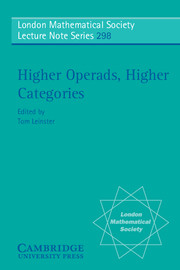Book contents
9 - A definition of weak n-category
Published online by Cambridge University Press: 08 January 2010
Summary
Vico took it for granted that the first language of humanity was in the form of hieroglyphics; that is, of metaphors and animated figures […] He had intimated war with just ‘five real words’: a frog, a mouse, a bird, a ploughshare, and a bow.
Eco (1995)Algebraic structures are often defined in a way that suggests conflict: generators vs. relations, operations vs. equations, composition vs. coherence. For example, in the definition of bicategory one equips a 2-globular set first with various composition operations, then with coherence isomorphisms to ensure that some of the derived compositions are, in fact, essentially the same. One imagines the two sides pulling against each other: more operations make the structure bigger and wilder, more equations or coherence cells make it smaller and more tame.
With this picture in mind, the most obvious way to go about defining weak n -category is to set up a family of higher dimensional composition operations subject to a family of higher-dimensional coherence constraints. This is the strategy in Batanin's and Penon's proposed definitions, both of which we discuss in Chapter 10. But it is not our strategy in this chapter.
In the definition proposed here, no distinction is made between composition and coherence. They are seen as two aspects of a single idea, ‘contraction’, not as opposing forces. This unified approach is in many ways more simple and graceful: one idea instead of two. Contractions are explained in Section 9.1. A map of globular sets may have the property of being contractible, which viewed topologically means something like being injective on homotopy; if so, it admits at least one contraction, which is something like a homotopy lifting.
- Type
- Chapter
- Information
- Higher Operads, Higher Categories , pp. 279 - 308Publisher: Cambridge University PressPrint publication year: 2004



